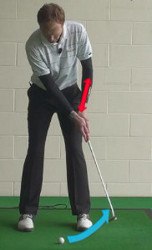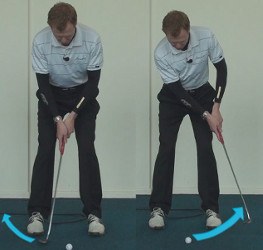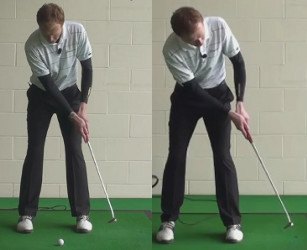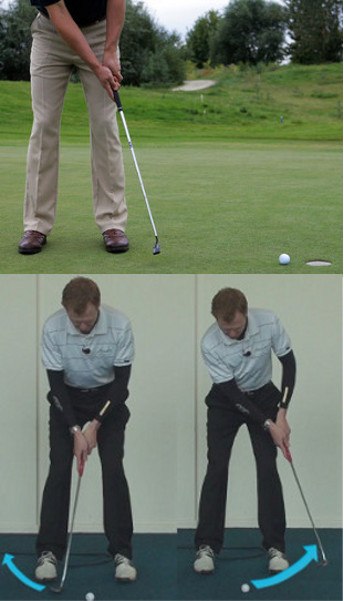
There’s no worse feeling in golf than standing over a 2-foot just knowing you’re going to miss it. How can such a short stroke be so difficult?
First, you should recognize that the “yips” – the term for the debilitating inability to hole short putts – aren’t just a golf phenomenon. They happen in other sports, too. Baseball is full of examples of second basemen who could throw a bullet to first from their knees, but couldn’t make a routine toss when they had plenty of time.
The yips are more about confidence than technique. Once you’ve missed one or two tap-ins, fear creeps in. Negative thoughts cloud the mind, the arms and shoulders tense up and your stroke goes haywire. Common technical causes include failure to accelerate the putter through the ball (aka “deceleration”), excessive wrist action and lifting the head too early (“peeking”).
Easy to get but sometimes hard to defeat, the yips afflict nearly every golfer at one time or another. Here are three basic ways to banish them from your game:

1. Decelerating putter: Make through-stroke longer than backstroke
Afraid they’ll hit the ball too hard, many golfers have difficulty making a firm, aggressive stroke from close range. If your putter head slows down as it nears the ball, the face turns over and you miss left and short. The best way to combat this tendency is to make a very short backstroke followed by a long follow-through. This forces you to accelerate into and beyond impact.
For a good drill, watch this video.
2. Excessive wrist action: Maintain the angle
Some golfers attempt to nudge the ball toward the hole by flipping the putter with the right wrist. This, too, causes weak, pulled putts. The key to consistent putting is making a pendulum-like stroke in which the arms and shoulders rock back and forth, with the hands and wrists remaining “quiet” throughout.
To prevent this flipping action, practice maintaining the angle formed by the back of your left hand and forearm as you stroke the ball. No need to tense up; simply keep the left wrist firm without locking the club in a death grip.

3. Peeking early: Listen for the ball
The golfer who lacks confidence is all the more likely to grow impatient. His head moves in concert with the putter as it meets the ball, pulling his shoulders and the club up and off track. It’s a tiny error, sometimes all but imperceptible, that can further damage a fragile psyche.
If peeking seems like an easy problem to fix, it is. Simply keep your eyes focused on the spot where your ball sits until you hear it hit the cup. (Or know that it’s rolled by.) You’ll strike the ball more solidly, preventing it from wobbling weakly off line.

Dealing with the Putting Yips Once and For All
There are two topics most golfers would prefer to avoid talking about if at all possible – the shank, and the putting yips. While hitting a shank might be a little more embarrassing, the yips can be just as damaging to your scorecard. You have to putt on basically every hole that you play, so getting the yips with the putter can lead to disastrous results by the end of the round. Not only will it hurt the scores that you shoot, it will also make the game less enjoyable to play. You won’t appreciate a great iron shot quite as much, for example, if you are panicked about having to try and make the putt.
What are the putting yips? Well, there probably isn’t a technical definition, but most golfers would say someone has the yips when they start missing a large number of their short putts (from about three feet and closer). Often, this comes along with a deterioration in the mechanics of their putting stroke – some golfers start to ‘jab’ at the ball awkwardly, while others fight a deceleration of the putter head. No matter how it happens to you, the only thing you should be concerned with is getting it fixed as quickly as possible.
Overcoming the yips is something that requires both physical and mental work. You will need to work on improving your technique to be sure, but much of the progress will have to be made between the ears. The act of hitting the ball into the hole from only a couple feet away is pretty simple, and most people can get it done without a problem on the practice green. However, when you get out onto the course, something changes in your mind and those short putts get a whole lot more difficult to make. To cure your putting yips once and for all, it is imperative that you solve whatever mental block you are dealing with.
Many golfers try to find the putting yips real cause in order to understand them better, but in reality there are many different possible causes. Sometimes, it really is as simple as a technical flaw in your putting stroke that is causing the ball to roll off line. For other golfers, it can be mental baggage that accumulates over the years as the rounds go by. If you miss a couple of short putts in crucial situations like a tournament at your club, those failures can get in your head and contribute to future misses. In the end, finding the putting yips real cause for you isn’t going to be all that important. The only thing that matters is conquering them so that you can putt better now, and so that they don’t come back in the future. Take the time to improve both your mental and physical approach to short putts and you should be able to say goodbye to the yips.
Before getting into the instruction, please note that everything included below is based on a right handed golfer. For those of you who are left handed players (or left handed putters, at least), be sure to reverse the directions.

Isolating the Physical Mistakes
Every golfer that struggles with the yips should confront the mental side of the equation at some point. However, prior to working on the mind games that go into putting, you need to make sure that your stroke itself isn’t causing too many problems. After all, if your putting stroke is out of whack, it won’t matter how well you are thinking – you aren’t going to make very many putts.
The best way to isolate the physical from the mental is to work on short putts on the practice green. There should be no nerves when you are practice putting, because it simply doesn’t matter if you make or miss. Therefore, you don’t have to worry about the mental side of the game causing you trouble and you can just see how the mechanics of your stroke hold up. Dedicate some practice time to working on your short putts and you will get a good idea of how you are rolling the ball when the pressure is off.
Try the following drill to get a good baseline indication of your current ability to make short putts –
- Take a handful of golf balls to the practice green along with your putter and a tee.
- Place the tee in the ground about three feet from the hole. Most regular-length putters are between 33’’ – 35’’ long, so you can use that as a guide to find the right distance from the hole. The putt you set up should be relatively flat so you don’t have to worry about the break of the putt complicating the process.
- Roll a total of 50 putts from the spot that you have marked out with your tee. Keep track of how many you make and miss as you go along. While this might seem like a lot of putts, it should only take a few minutes because you are starting so close to the hole.
Give this drill your best effort and pay full attention to each of the putts. Don’t make any technical changes or adjustments to your stroke as you go, either – just hit all of the putts with your regular stroke and see where you end up at the completion of the drill.
So, how many did you make out of 50? If you made 45 or more, your stroke is in pretty good shape. There are bound to be a couple misses along the way, due to either a lapse in concentration or maybe even a bump in the green. You should feel very good about missing less than five putts out of 50 tries. If you made between 40 – 45, your stroke is still in pretty good shape, but could probably use a little bit of work to improve consistency.
It is when you are making fewer than 40 putts out of 50 that you need to take a serious review of the mechanics of your putting stroke. Given that this drill is done with a flat three foot putt and no pressure, making less than 80% provides you room for significant improvement. Prior to having success on the course making short putts, you need to get the technique ironed out on the practice green.

Two Common Mechanical Errors
If you find yourself struggling to make short putts even without the presence of pressure, it is a good bet that there is a mechanical flaw in your putting stroke. Of course, there could be countless potential issues in your stroke, and taking a lesson from a local pro is a good way to get on the right track. With that said, the following are the two most common mechanical errors when it comes to short putting strokes. Check your own technique to make sure neither one of these problems is affecting you.
- Head moves early. This is probably the one most commonly associated with the putting yips. As the putter starts to swing toward the ball, your eyes and head lift up early to look at the hole. As a result, the putter isn’t able to quite swing through impact properly, the blade is left open (pointing to the right of the hole), and the putt misses the mark. Golfers who have trouble with short putts always missing to the right will usually find that head movement is to blame. It doesn’t have to be a lot of movement either – just a subtle look up toward the hole prior to contacting the ball is enough to cause a miss.
- Backstroke is too long. The other frequent mistake amateur golfers make is using too long of a backstroke for a short putt. It requires very little in the way of power to get the ball to the hole from three feet away, so you should keep your backstroke short and compact. When it gets too long, you will have to slow the putter down as it heads into the ball so you don’t hit the putt too hard. This slowing down of the putter head usually causes the putter face to close prior to impact and the ball is sent left of the hole.
Those struggling with the first problem, looking up early, should work on keeping their eyes fixed on one spot until after the ball is gone. As long as you keep your eyes still during the stroke, you can expect that your head will stay still as well. One trick to help you achieve this is to draw something on your golf ball and then place your ball on the green so that your drawing is pointing up to the sky. At address, fix your eyes on that spot and don’t look away until after the ball is gone. This might seem simple, but a little practice using this trick can quickly fix the problem you have of looking up too early.
One other practice drill to solve this problem is to require yourself to listen for the ball to go into the hole, instead of watching it. On the practice green, try to make ten short putts in a row without watching any of them actually fall in. As long as you hear the ball rattle into the bottom of the cup, you will know you have made a good stroke.
Addressing the other mechanical flaw that you might be dealing with, a long backstroke, also requires some simple work on the practice green. To get started, set up the same drill as you used to test your performance on short putts with a tee in the green at three feet away from the hole. This time, place a couple more tees in the green that are a few inches behind your putter head. As you make your stroke, you will be unable to let it go too long during the backstroke portion because those tees will be in your way. Your only option will be a nice, compact stroke that accelerates through the ball. The one thing you need to watch out for when doing this drill is to not rush through your putting stroke just because it is shorter. It is still important to have good rhythm and tempo during the stroke, even if your backstroke is only a few inches long.
There is a good chance that just by taking a look at those two potential mistakes in your short putting stroke, you will have yourself back on track on the practice green. If you wish, you could repeat the 50 putt drill now that you have made some improvements to see how your performance has changed. Hopefully, the number of short putts you can make out of 50 will have increased as a direct result of your hard work.

The Mind Games
Fixing physical problems on the putting green is a simple task compared to solving the mind games that you might be dealing with. Golf is a game that is all about pressure, and that pressure manifests itself in the form of nerves and mental lapses. Even if you are only playing a round of golf by yourself with no one else around, there is still pressure because you always want to do your best and shoot a good score. One of the reasons that so many golfers love the game is because of the opportunity it gives you to test yourself - both physically and mentally. There isn’t a much better feeling on the golf course than knowing you are nervous over a particular shot, and succeeding anyway.
There are a few reasons that the putting tips can become such a mental challenge for many golfers.
- Short putts should be easy. Or at least that is what many golfers think. When you stand over a short putt, your mind is telling you that you should be able to make the putt without much problem. Instantly, this message makes you feel nervous because of the expectation of success. What if you miss? You will have wasted a stroke when you should have had no problem making the putt.
- The pay-off for other shots. When you hit a great shot into the green, you want to be rewarded with a birdie. After all, that beautiful iron shot is only memorable if it ends with you sinking the putt nicely. Therefore, when you get to the green and address the short putt, you start to feel anxious, not wanting to ‘ruin’ the good shot you just hit.
- Greens aren’t perfect. Even the nicest golf courses have imperfections in their greens in many spots – it’s just part of the game. Most of the time, your ball will just roll right over them and continue straight on the path that you sent it on. However, sometimes those imperfections will affect the putt and cause it to miss. If you are worried about your ball hitting something on the green surface, your mind won’t be fully committed to the task of rolling the ball into the hole.
- Situational pressure. There is nothing like game pressure to make you lose track of your proper technique. If you are playing a match at your local club, for example, the pressure of getting down toward the end of the match and needing to make a short putt could be too much to handle. Golfers of all skills levels know the incredible power that pressure can have in terms of causing you to perform at something less than your best – and nowhere is that more evident than on the putting green.
In reality, you probably didn’t need an explanation of the various ways short putts can get in your head, because you have experienced them on the course for yourself. Everyone reacts to pressure and nerves differently, but there is one method for dealing with them that will work for almost any golfer.
To cure your putting yips once and for all, focus on the process of making a short putt and forget about everything else around you that you can’t control. It doesn’t matter what is on the line for a given putt. It doesn’t matter if there are a couple of imperfections on the green, or if you have already missed a short putt earlier in the round. The only thing that matters is going through your process and sticking with a routine that will lead to positive results. Block everything else out and trust the process – this is the key to overcoming the yips.
If you don’t have an established process for hitting your short putts, consider using the one outlined below. Of course, you can make minor changes as necessary to make it better suit your personal playing style.
- As you mark your ball and pick it up to clean it, take a quick look at the line of the upcoming short putt. Most short putts don’t require a lot of reading, as you are usually going to play them on a line that is ‘inside the hole’. Still, you need to make a quick read to assess the break and pick a target line.
- With your target line picked, place the ball back down on the green and take a couple steps back. From here, go through a quick visualization process. Picture the ball rolling along your target line and directly into the hole.
- Step up next to the ball and take one practice stroke, focused on the rhythm and tempo of your stroke. You don’t want to be thinking too many mechanical thoughts at this point – just swing the putter back and through to get a good feeling into your hands.
- Step up to the ball and take your address position. Look once at the hole, then back down at the ball, and start your stroke. There should be no more hesitation than that. If you stand there waiting to make your stroke, you are only going to be allowing more time for bad thoughts to creep into your head. Don’t rush, but keep a quick rhythm so your mind doesn’t start to wander.
With this kind of putting routine in place, the yips will quickly become history. Dealing with the putting yips is all about lacking confidence and the ability to execute the same simple motion over and over again in your putting stroke. Routine builds consistency, and consistency will destroy the yips.

Confront the Problem Right Away
It is easy to fall into the trap of trying to ignore the putting yips, just hoping that they will go away. Unfortunately, they are unlikely to go away all on their own. Instead, you are going to need to accept the fact that you have a problem with making short putts, and then get down to work on fixing both the physical and mental side of the equation. You might not want to realize that you have the yips, but the sooner you do so, the sooner you can get to work on correcting them.
Don’t let the putting yips lessen your enjoyment of the game or cause you to shoot higher and higher scores as time goes by. Golf isn’t nearly as fun when you have to worry about every two and three footer that you face throughout a round. Making short putts doesn’t require a whole lot in the way of physical skill, but it does take some mental fortitude and a commitment to practicing your technique. Hopefully, the information above will help you better understand the putting yips and what can be done to counter them. You don’t have to deal with the yips forever – and you probably don’t even have to put up with them for a single round longer. Get to work on the practice green and take to the course with confidence knowing that the yips are safely behind you.





